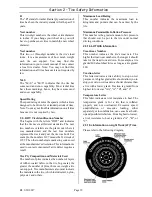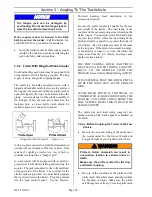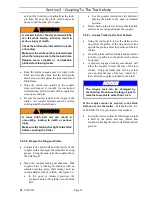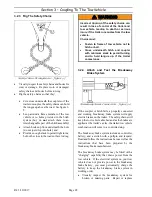
R4 3/30/2017
Page 31
4 L
OADING THE
T
RAILER
Improper trailer loading causes many accidents and
deaths. To safely load a trailer, you must consider:
•
Overall load weight;
•
Load weight distribution;
•
Proper tongue weight; and
•
Securing the load properly.
Your Featherlite Coach Trailer may be equipped
with a vehicle lift. It is possible to create a
hazardous center of gravity by having heavier cargo
on a raised platform. Plan your cargo so that the
heavier cargo is secured beneath the raised lift.
To determine that you have loaded the trailer within
its rating, you must consider the
distribution
of
weight, as well as the total weight of the trailer and
its contents. The trailer axles carry most of the total
weight of the trailer and its contents (Gross Vehicle
Weight, or “GVW”).
The remainder of the total weight is carried by the
tow vehicle hitch. It is essential for safe towing that
the trailer tongue and tow vehicle hitch carry the
proper amount of the loaded trailer weight,
otherwise the trailer can develop an undesirable
sway at towing speeds, or the rear of the towing
vehicle can be overloaded. Read the “Tongue
Weight” section that follows.
The load distribution must be such that no
component part of the trailer is loaded beyond its
rating. This means that you must consider the
rating of the tires, wheels and axles. You must
make sure that the front-to-rear load distribution
does not result in overloading any axle.
Proper load distribution is also essential to provide
predictable handling. If you load the trailer with
too little tongue weight, the trailer will be inclined
to suddenly begin to sway when towed at highway
speed. A rule of thumb for the coach trailer is:
Tongue weight should be 10% of the total weight of
the trailer plus cargo (Gross Vehicle Weight, or
“GVW”). Towing stability also depends on
keeping the center of gravity as low as possible.
•
Load heavy items on the floor and over the
axles.
•
Do not carry heavier items on a raised lift.
•
Load additional items evenly, right to left, to
achieve uniform tire loading.
•
Distribute the load front to obtain proper
tongue weight.
^ WARNING
An overloaded trailer can result in failure or
in loss of control of the trailer, leading to
death or serious injury.
Never load a trailer so that the weight on
any tire exceeds its rating.
Never exceed the trailer Gross Vehicle
Weight Rating (GVWR).
Never exceed an axle Gross Axle Weight
Rating (GAWR).
Tongue Weight
It is critical to have a portion of the trailer load
carried by the tow vehicle. That is, the trailer
tongue must exert a downward force on the hitch.
This is necessary for two reasons. First, the proper
amount of tongue weight is necessary for the tow
vehicle to be able to maintain control of the tow
vehicle/trailer system. Also, even if there is some
weight on the tongue, but not enough weight on the
tongue, the trailer can become unstable at high
speeds. Remember, the faster you go, the more
likely the trailer is to sway.
In addition to tow vehicle control, tongue weight is
necessary to insure that the trailer axles do not
exceed their Gross Axle Weight Rating (GAWR).
4.1 C
HECKING
T
ONGUE
W
EIGHT
To check the tongue weight, the tow vehicle and
trailer must be on level ground, as they will be
when the trailer is being towed.
If you know the weight on your tow vehicle axles
when you are not towing a trailer, trailer tongue
weight can be determined with the use of a truck
axles scale.
Содержание COACH TRAILERS
Страница 1: ...COACH TRAILERS OWNER S MANUAL...
Страница 6: ......






























